#Updated instrument cluster
Explore tagged Tumblr posts
Link
Adventure Tourer Bikes, Cruiser Bikes, Off Road Bikes Petrol Single cylinder, 4 Stroke, Liquid Cooled, DOHC 30.2 PS @ 8000 rpm Whiteout ₹ 2,19,942Sports Naked Bikes, Sports Bikes Petrol Liquid Cooled, Triple Spark, 4-Valve FI DTS-i 6-speed 24.5 PS @ 9750 rpm Glossy Ebony Black, Metallic Pearl White, Cocktail Wine Red - White, White, Pewter Grey - Blue ₹1,49,363
#Petrol#Dual ABS#Cruiser Bike#Disc Brakes#Rs.219942Sports Naked Bike#Sports Bike#Motorcycle#Updated instrument cluster#Gear position indicator#Fuel economy indicator#Dual channel ABS#200cc motorcycle#BS6 motorcycle#Streetfighter motorcycle#Affordable motorcycle#Fuel-efficient motorcycle#Stylish motorcycle#Beginner-friendly motorcycle#Fun-to-ride motorcycle#Single-cylinder motorcycle#DTSi FI engine#Liquid cooled engine#6-speed transmission#Upside down forks#Dual disc brakes
0 notes
Text


This week was a productive one. I've been studying microservices to better understand distributed systems. At the bus company where I work, we use a monolithic system—an old-school setup style with MySQL, PHP, some Java applications, localhost server and a mix of other technologies. However, we've recently started implementing some features that require scalability, and this book has been instrumental in helping me understand the various scenarios involved.
In the first chapters, I've gained a clearer understanding of monolithic systems and the considerations for transitioning to a distributed system, including the pros and cons.
I've also been studying Java and Apache Kafka for event-driven architecture, a topic that has captured my full attention. In this case, the Confluent training platform offers excellent test labs, and I've been running numerous tests there. Additionally, I have my own Kafka cluster set up using Docker for most configurations.
With all that said, I've decided to update this blog weekly since daily updates it's not gonna work.
#coding#developer#linux#programming#programmer#software#software development#student#study blog#study aesthetic#studyblr#self improvement#study#software engineering#study motivation#studyblr community#studying#studynotes#learning#university#student life#university student#study inspiration#brazil#booklr#book#learn#self study#java#apachekafka
21 notes
·
View notes
Text


















1969 S14-Powered BMW 2002: currently on Craigslist. Here's a link.
"Offered for sale is this modified 1969 BMW 2002, a unique and well-executed build that combines vintage charm with modern performance enhancements. This example features a wide array of mechanical upgrades and cosmetic modifications designed to improve handling, driving dynamics, and style, while preserving the engaging driving experience BMW is known for.
Exterior & Body: The car is finished in Alpine white with a tasteful blue vinyl accent wrap, which can be removed if the new owner desires. The standout feature of this 2002 is its Alpina widebody kit, often referred to as "pig cheeks," which gives the car a muscular stance. It sits on 13-inch Minilite wheels wrapped in Toyo R888R tires that look to be nearly new, offering excellent grip for spirited driving. Other exterior modifications include a Koogle Works front lip, chrome molding delete, and a brand-new rear bumper. The bodywork shows some imperfections typical of a driver-focused car but remains in good overall condition.
Interior: The interior of this 2002 is equally well-appointed, featuring black vinyl seats with cloth inserts. The front seats are E21 Recaro buckets, while the rear seats have been upgraded to BMW E24 units, reupholstered in classic houndstooth fabric. The dashboard is in excellent condition, crack-free, and complemented by modern Alpina-style instrument cluster gauges for improved visibility and style. Additional updates include a suede Personal steering wheel, Alcantara headliner, and new carpeting and door panels.
Mechanical & Drivetrain: Under the hood, the car is powered by an S14 engine sourced from an E30 M3, with 105k miles on the donor motor. This engine provides significant performance improvements over the original powerplant, and is paired with a 5-speed manual transmission and a limited-slip differential (LSD) for improved handling and driving dynamics. The suspension has been upgraded with BC coilovers at the front and Bilstein shocks at the rear, providing an excellent balance of comfort and performance. Volvo front calipers help provide increased braking power, while the custom exhaust system adds a distinctive note to the driving experience. Other notable mechanical modifications include a relocated battery to the trunk, a strut brace, and an E21 radiator. The car also features a brand-new OEM clutch and fresh front and rear glass.
Electrical & Features: While most electrical components work as expected, the driver’s side blinker and the horn are currently non-operational. The car features a complete set of beautiful modern instruments and gauges, adding a sleek and functional touch to the cabin.
Condition: This 1969 BMW 2002 is in great running condition, with no rust present and a clear, clean title. While there are minor imperfections in the bodywork, it is far from a concours-level show car. Instead, this is a well-built, reliable example designed to be driven hard and enjoyed on the road. The car has never been involved in any accidents, and its modifications were made with performance in mind.
Included in the Sale: The sale includes no additional accessories, as the car is being offered as is. The new owner will enjoy a truly engaging driving experience, thanks to its upgraded suspension, potent engine, and timeless BMW styling.
Known Issues:
The driver’s side blinker and horn are currently not working.
Minor imperfections in the bodywork.
Will provide service history upon request.
This car is a fantastic example of a classic BMW that has been thoughtfully upgraded with performance-oriented parts while maintaining its iconic 2002 driving experience. With its combination of modern performance and vintage style, it is a true driver’s car that’s ready to be enjoyed."
7 notes
·
View notes
Link
Explore Hubble Hubble Home Overview About Hubble The History of Hubble Hubble Timeline Why Have a Telescope in Space? Hubble by the Numbers At the Museum FAQs Impact & Benefits Hubble’s Impact & Benefits Science Impacts Cultural Impact Technology Benefits Impact on Human Spaceflight Astro Community Impacts Science Hubble Science Science Themes Science Highlights Science Behind Discoveries Hubble’s Partners in Science Universe Uncovered Explore the Night Sky Observatory Hubble Observatory Hubble Design Mission Operations Missions to Hubble Hubble vs Webb Team Hubble Team Career Aspirations Hubble Astronauts News Hubble News Hubble News Archive Social Media Media Resources Multimedia Multimedia Images Videos Sonifications Podcasts e-Books Online Activities Lithographs Fact Sheets Posters Hubble on the NASA App Glossary More 35th Anniversary Online Activities 2 min read Hubble Captures a Neighbor’s Colorful Clouds This NASA/ESA Hubble Space Telescope image features part of the Small Magellanic Cloud. ESA/Hubble & NASA, C. Murray Download this image Say hello to one of the Milky Way’s neighbors! This NASA/ESA Hubble Space Telescope image features a scene from one of the closest galaxies to the Milky Way, the Small Magellanic Cloud (SMC). The SMC is a dwarf galaxy located about 200,000 light-years away. Most of the galaxy resides in the constellation Tucana, but a small section crosses over into the neighboring constellation Hydrus. Thanks to its proximity, the SMC is one of only a few galaxies that are visible from Earth without the help of a telescope or binoculars. For viewers in the southern hemisphere and some latitudes in the northern hemisphere, the SMC resembles a piece of the Milky Way that has broken off, though in reality it’s much farther away than any part of our own galaxy. With its 2.4-meter mirror and sensitive instruments, Hubble’s view of the SMC is far more detailed and vivid than what humans can see. Researchers used Hubble’s Wide Field Camera 3 to observe this scene through four different filters. Each filter permits different wavelengths of light, creating a multicolored view of dust clouds drifting across a field of stars. Hubble’s view, however, is much more zoomed-in than our eyes, allowing it to observe very distant objects. This image captures a small region of the SMC near the center of NGC 346, a star cluster that is home to dozens of massive young stars. Facebook logo @NASAHubble @NASAHubble Instagram logo @NASAHubble Media Contact: Claire Andreoli ([email protected])NASA’s Goddard Space Flight Center, Greenbelt, MD Share Details Last Updated Mar 21, 2025 Editor Andrea Gianopoulos Location NASA Goddard Space Flight Center Related Terms Hubble Space Telescope Astrophysics Astrophysics Division Galaxies Goddard Space Flight Center Magellanic Clouds The Universe Keep Exploring Discover More Topics From Hubble Hubble Space Telescope Since its 1990 launch, the Hubble Space Telescope has changed our fundamental understanding of the universe. Hubble’s Night Sky Challenge Hearing Hubble Reshaping Our Cosmic View: Hubble Science Highlights
4 notes
·
View notes
Text
How Will The Universe End? A Changing Understanding of Dark Energy May Provide A New Answer
— By Adithi Ramakrishnan | March 19, 2025 | Associated Press

This Image Provided By NSF's NOIRLab Shows the Trails of Stars Above Kitt Peak National Observatory, Where a Telescope is Mapping the Universe to Study a Mysterious Force Called Dark Energy. NSF's NoirLab via Associated Press
New York (AP) — Scientists are homing in on the nature of a mysterious force called dark energy, and nothing short of the fate of the universe hangs in the balance.
The force is enormous - it makes up nearly 70% of the universe. And it is powerful - it is pushing all the stars and galaxies away from each other at an ever faster rate.
And now scientists are getting a little closer to understanding how it behaves. The big question is whether this dark energy is a constant force, which scientists have long thought, or whether the force is weakening, a surprising wrinkle tentatively proposed last year.
Results presented at a meeting of the American Physical Society Wednesday bolster the case that the force is weakening, though scientists are not yet certain and they still haven't worked out what this means for the rest of their understanding of the universe.
The updated findings come from an international research collaboration that is creating a three-dimensional map to see how galaxies have spread and clustered over 11 billion years of the universe's history. Carefully tracking how galaxies move helps scientists learn about the forces that are moving them around.
Called the Dark Energy Spectroscopic Instrument, the collaboration released its first analysis of 6 million galaxies and quasars last year and has now added more data, bringing the count to nearly 15 million. Their updated results, taken with other measurements - exploding stars, leftover light from the young universe and distortions in galaxy shape - support the idea presented last year that dark energy may be waning.
"It's moving from a really surprising finding to almost a moment where we have to throw out how we've thought about cosmology and start over," said Bhuvnesh Jain, a cosmologist with the University of Pennsylvania who was not involved with the research.
It's not time to completely rule out the idea that dark energy is constant because the new results are still shy of the gold standard level of statistical proof physics requires. The collaboration aims to map around 50 million galaxies and quasars by the end of its survey in 2026. And other efforts around the globe have an eye on dark energy and aim to release their own data in the coming years, including the European Space Agency's Euclid mission and the Vera C. Rubin Observatory in Chile.
"We want to see several different collaborations having similar measurements" at that gold standard to be sure that dark energy is weakening, said cosmologist Kris Pardo with the University of Southern California who was not involved with the new research.
If dark energy is constant, scientists say our universe may continue to expand forever, growing ever colder, lonelier and still.
If dark energy ebbs with time, which now seems plausible, the universe could one day stop expanding and then eventually collapse on itself in what's called the Big Crunch. It might not seem like the cheeriest fate, but it offers some closure, said cosmologist and study collaborator Mustapha Ishak-Boushaki of the University of Texas at Dallas.
"Now, there is the possibility that everything comes to an end," he said. "Would we consider that a good or bad thing? I don't know."
The Associated Press Health and Science Department receives support from the Howard Hughes Medical Institute's Science and Educational Media Group and the Robert Wood Johnson Foundation. The AP is solely responsible for all content.
— Adithi Ramakrishnan is a Science Reporter for The Associated Press, Based in New York. She Covers Research and New Developments Related to Space, Early Human History and More.
#Science#Universe#Dark Energy#Changing Understanding#New Revelation#Mysterious Force#NSF's NOIRLab#Kitt Peak National Observatory#Telescope 🔭#Mapping | Universe#Adithi Ramakrishnan#Associated Press
2 notes
·
View notes
Note
Can't remember if I've asked you yet (I have the memory of a goldfish) but it's STS time!
What's the solar system like in your setting? Anything funky? If not, do people have any cool myths about constellations or celestial bodies?
Have a wonderful day <3
This is going to be a long post, sorry about that. A lot of this is information from way back when I first created this blog, though the information has been updated.
This is an explanation for the Creation, Cosmology, and some of the Races of my WIP. Lots of Worldbuilding nonsense if that's what y'all like.
Ask questions, if y'all want!
The Universe of the Testaments

Pictured Above: An Approximation of the Solar System of Kobani. Kobani is signified by the Green dot. Note that this is by no means at scale and the 5 planets of the solar system should have far wider orbits and should be far smaller in comparison to the central star.
Understanding the Cosmological makeup and function of the universe in which Kobani resides requires that one first understand the magical and divine aspects of the universe and its ultimate creation. For the purposes of this post I will be using the terms used in the Kishic faith to describe the mechanics of the universe.
Most of what humans know about the greater universe and its magical elements come from the testimony of spirits and other ancient beings including the Dragon, Ilhumba, The Storyteller. (I will probably give more details about Ilhumba in a later post, suffice to say that Ilhumba is responsible for many of the myths and religions of Kobani but also for most of the terrible things)
Continues below the cut!
The River of Creation, The First Ones, and The Heavenly Gods
The Universe (in truth a conglomeration of distinct dimensions/mini-universes clustered around a singular point) exists within a torrent of cosmic creation, The River of Creation.
The River, known by the people of Kishetal as the Shobiash, has always flowed through the Endless Void that is the Chaotic Nothing, its source and its end, if they exist, are only be known by those beings who wander its far shores. The greatest of them are Law and End, who oversee that which is, that which will be, and that which must be.
The River is all, it is existence, matter, energy, and time. All mortal things are born from the River, and all mortal things one day return to it. Worlds, universes, pantheons, they have emerged and sunk back into the golden eddies. The current universe, that of Kobani and the other celestial spheres emerged in the same way and will, in time, return. There are countless universes doting and permeating the River. The Universe of the Testament can be considered just one of these universes, a fragile island in the torrent.
The separation of the Testament Universe into distinct dimensions was instrumented by the first set of "Gods" to emerge from the cosmic current and inhabit that particular universe. They constructed and shaped these dimensions around a singularity, which allowed for these places to be connected while also existing in their own space and time. There are 13 distinct dimensions, each with their own countless stars, planets, etc.
These First Gods would then return to their River, their fate unknown, whether they merely melted back into the current or journeyed to a different universe. What is known is that, they left in their wake offspring, beings born of a mixture of the Cosmic chaos and Universal "Scraps." These would become the Heavenly Gods.
The Heavenly Gods are the arbiters and keepers of order and natural law, most notably the Awakened cycle of reincarnation and the proliferation of life on the mortal and spiritual worlds (this will be explained further below). Gods cannot die except by their essence being forcibly returned to the Great River or with the ending of the Universe. The appearance and even number of gods are in constant flux as a god, through choice or circumstance, may split into multiple entities or else recombine into a greater entity. However, their essence and soul are static. As an example, a god such as Fepacha may simultaneously be seven beings while still being of one essence and soul. This is part of why so many gods appear in various religions across Kobani.
The sheer magical energy which radiates from these beings when in their whole forms is intensely powerful; most of the lingering “wild magic” in Kobani is the result of multiple gods visiting the planet while in their whole forms. As a result, the gods rarely venture outside of their spheres and take little interest in the matters of mortals, with a few exceptions.
The Gods inhabit the singularity, and domain which lies within it, which is itself shrouded by the central star or sun of these dimensions and their solar systems. Thus the gods of Kobani in some sense reside within the sun.
The Awakened Cycle of Reincarnation
The Awakened is a term used to refer to the five races which stem from a singular primitive species which developed and evolved naturally on Kobani. Similar occurrences happened in the other worlds as well. These primitive beings were exposed to powerful magic by the gods and, in addition, were given mortal souls that could not only continue the process of reincarnation through the mortal worlds as all living things do, but could now permit for the soul to ascend out of the mortal worlds, with soul or 'het', being reincarnated a number of times before coming to inhabit the world of the gods. It is not entirely clear why the gods created the awakened races, though it is believed that mortals in time come to serve the gods with the collective experience of several lifetimes. How many lives a het will experience before this time varies, though typically a soul will reincarnate at least 7 times, thus explaining Kishic mythology.
The Awakened Races of Kobani
(Any of the groups below which is exposed to and drastically changed by magic is referred to a forestfolk, though most typically the term forestfolk is referencing groups descended from magically altered humans.)
Humans: The most populous of the awakened, incapable of using magic themselves but capable of communication with spirits. Humans are also unique in their ability to produce offspring with spirits which are known as Spiritbloods, or more inaccurately Demigods. Those humans which can communicate with spirits naturally and use channel spirit magic are known as sages and seers.
Giants: Massive humanoid beings, like humans, they are incapable of using magic themselves; however, much like a Spiritblood, their physical form is supported by magic, allowing for their bodies to reach massive sizes without the biological or physical limits and drawbacks which should affect them. After the Calamity, giants are rare and much reduced in size, though they are still far larger than the typical human. Giants are never born as sages, and are typically unable to commune with spirits except via the use of magical potions and herbs.
The Hillfolk: Small fur-covered beings naturally capable of minor magic (true magic, not sagecraft). The Hillfolk were once a numerous nomadic race that roamed Kobani, but their numbers were greatly reduced by human oppression and then the Calamity. A few small bands still exist, but they are typically confused for forestfolk.
The Stonefolk: About human-sized but broader with larger eyes and powerful arms, well suited to their preferred underground environment. The stonefolk were the only group that regularly interbred with humans, and indeed they were eventually bred out of existence. All modern humans of Kobani have some stonefolk ancestry, as a result the humans of the post-calamity era are typically shorter and broader than their ancient counterparts.
The Forest Tenders: Slender and tall green-skinned beings. The Forest Tenders, as their name suggests, preferred the forest and often dedicated themselves to its care. Though the most magically capable race, their child-like intellect and emotional capacity largely limited the Forest Tenders from expanding past their groves and forests. The Forest Tenders were annihilated by humans and stonefolk prior to the Calamity and are now extinct.
Note that these examples are just on Kobani, each world has their own array of awakened races, and some may only have one. Some dimensions may have multiple worlds containing awakened species. Not all planets inhabited by Awakened peoples are in the same solar systems as the Singularity, though most, like Kobani, are. A mortal does not need to reincarnate into the same species so long as it is sapient, and except for in rare occasions when the soul is reincarnated on the same world, they won't.
Unlike the Unawakened, these new beings, the Awakened, would retain their memories and experiences as they reincarnated. However, such memories would become dormant until reaching the worlds of the Gods, where a soul would then become the amalgamation of all of its past lives and experiences.
The exception, it seems, comes from the judgment given by the Deity of Death. If a lifetime is considered wicked or undeserving, or if the soul wishes to forget that lifetime, they could be born again in the same world as the previous life, with their past experiences in that world vanishing from their collective soul. Upon a being’s death and after being judged, the soul is transported to the next world in the cycle and given new life. As a result, a sudden increase in deaths in one world will inevitably lead to a burst in new births in the other worlds.
As such certain actions, such as the destruction of souls by humans before the Calamity, can have drastic effects on other worlds, and indeed a single war or similar event may have rippling effects through all of the mortal worlds.
Not all souls will follow the same path or go through worlds in the same order. While the people of Kishetal believe that souls are first born or created on Kobani, this is not necessarily true and a soul may begin its journey on any of the four mortal worlds.
Animals and plants may only reincarnate within the mortal worlds. Should a spirit be killed it will reincarnate on the world on which they were first created and may then travel to other worlds via the singularity or through various other tears and bends in the dimensions. Unlike mortal beings, a spirit will retain its personality and most of its memories upon reincarnation. A spirit cannot reincarnate into a mortal and a mortal can not become a spirit. There are certain worlds which lack sentient species but do contain spirits. Stories of these worlds from spirits, is the origin of the Kishic concept of the "spirit world(s)."
Spiritbloods, though the product of hybridization with humans and spirits, reincarnate in the same way as normal mortals, and a spiritblood does not need to reincarnate as a spiritblood.
The Cosmology of the Solar System of Kobani: Myth and Reality

Pictured Above: The Kishic Conception of the Cycle of Reincarnation. Green planets in the outer ring are the mortal worlds, blue planets in the middle ring are spirit worlds, and the golden planets alongside the star, Re, are the worlds of the Gods.
The people of most of Kobani’s cultures are under the impression that the other worlds all exist in the same solar system, though of course this is not actually the case.
The Kishic conception of the solar system
It is a common belief in Kishetal that the solar system, which they believe holds all worlds in the cycle of reincarnation, consists of three Great Walls, which separate the disparate worlds from each other.
Devami: The Wall separating the First Realm; home of the four mortal worlds, Kobani, Sebani, Robani,and Mobani; from the rest of the universe. Note: Ko, Se, Ro, and Mo originate from an archaic form of Shabalic. Each refers to a time of day; Kosa: Morning, Sesa: Noon, Rosu: Evening, and Mosa: Night. These terms have largely fallen out of use in Kishetal and only exist in compound words. Bani is the Kishic word for world or planet. Ami originates from the Shabalic word for wall, Amiha. Dev comes from a Kishic word for other or foreigner.
Bisami: The Wall separating the First Realm from the Second or Spirit Realm, home to the 4 spirit worlds, Kobashi, Sebashi, Robashi, and Mobashi. Bashi originates from the Kishic word for spirit, babashi.
Shinami: The Wall separating the Second Realm from the Third Realm, Home of the Noble Gods and its four worlds, Kochani, Sechani, Rochani, and Mochani. Chani originates from the Shabalic word for god: Chan (Chani pl.) The Kishic equivalent to this is Kan (Kani pl.)
The Actual Solar System of Kobani

The Actual solar system of Kobani consists of 5 planets, each with its own satellites. The closest planet to the star, Re, and the smallest, is known by the people of Kishetal as Sebani; the second farthest planet is referred to as Robani; and the planet which lies beyond Kobani is called Mobani. There is a fifth planet and, beyond it, several dwarf planets that are unknown to the people of Kobani. Beyond that still is an extensive asteroid belt. Kobani is largely protected from asteroids by the Unknown planet and Mobani, though there have been instances in Kobani’s ancient past where the planet has been struck.
The Unknown planet and Mobani are both primarily formed from gasses, while the three interior planets are rocky. Kobani is the only planet in that solar system with life. Kobani’s satellite, known in Kishic as Son, is the largest moon in the solar system.
@patternwelded-quill @flaneurarbiter @skyderman @blackblooms @roach-pizza @illarian-rambling @dezerex @theocticscribe @axl-ul, @persnickety-peahen
If y'all have more questions about this big mess please ask!
#writeblr#writing#fantasy#wip#worldbuilding#fantasy writing#fantasy world#fantasy race#sts asks#ask answered#sts#queer fantasy#world building#testamentsofthegreensea
14 notes
·
View notes
Text




ESO telescope captures the most detailed infrared map ever of our Milky Way
Astronomers have published a gigantic infrared map of the Milky Way containing more than 1.5 billion objects ― the most detailed one ever made. Using the European Southern Observatory’s VISTA telescope, the team monitored the central regions of our Galaxy over more than 13 years. At 500 terabytes of data, this is the largest observational project ever carried out with an ESO telescope.
“We made so many discoveries, we have changed the view of our Galaxy forever,” says Dante Minniti, an astrophysicist at Universidad Andrés Bello in Chile who led the overall project.
This record-breaking map comprises 200 000 images taken by ESO’s VISTA ― the Visible and Infrared Survey Telescope for Astronomy. Located at ESO’s Paranal Observatory in Chile, the telescope’s main purpose is to map large areas of the sky. The team used VISTA’s infrared camera VIRCAM, which can peer through the dust and gas that permeates our galaxy. It is therefore able to see the radiation from the Milky Way’s most hidden places, opening a unique window onto our galactic surroundings.
This gigantic dataset [1] covers an area of the sky equivalent to 8600 full moons, and contains about 10 times more objects than a previous map released by the same team back in 2012. It includes newborn stars, which are often embedded in dusty cocoons, and globular clusters –– dense groups of millions of the oldest stars in the Milky Way. Observing infrared light means VISTA can also spot very cold objects, which glow at these wavelengths, like brown dwarfs (‘failed’ stars that do not have sustained nuclear fusion) or free-floating planets that don’t orbit a star.
The observations began in 2010 and ended in the first half of 2023, spanning a total of 420 nights. By observing each patch of the sky many times, the team was able to not only determine the locations of these objects, but also track how they move and whether their brightness changes. They charted stars whose luminosity changes periodically that can be used as cosmic rulers for measuring distances [2]. This has given us an accurate 3D view of the inner regions of the Milky Way, which were previously hidden by dust. The researchers also tracked hypervelocity stars — fast-moving stars catapulted from the central region of the Milky Way after a close encounter with the supermassive black hole lurking there.
The new map contains data gathered as part of the VISTA Variables in the Vía Láctea (VVV) survey [3] and its companion project, the VVV eXtended (VVVX) survey. “The project was a monumental effort, made possible because we were surrounded by a great team,” says Roberto Saito, an astrophysicist at the Universidade Federal de Santa Catarina in Brazil and lead author of the paper published today in Astronomy & Astrophysics on the completion of the project.
The VVV and VVVX surveys have already led to more than 300 scientific articles. With the surveys now complete, the scientific exploration of the gathered data will continue for decades to come. Meanwhile, ESO’s Paranal Observatory is being prepared for the future: VISTA will be updated with its new instrument 4MOST and ESO's Very Large Telescope (VLT) will receive its MOONS instrument. Together, they will provide spectra of millions of the objects surveyed here, with countless discoveries to be expected.
Notes
[1] The dataset is too large to release as a single image, but the processed data and objects catalogue can be accessed in the ESO Science Portal.
[2] One way to measure the distance to a star is by comparing how bright it appears as seen from Earth to how intrinsically bright it is; but the latter is often unknown. Certain types of stars change their brightness periodically, and there is a very strong connection between how quickly they do this and how intrinsically luminous they are. Measuring these fluctuations allows astronomers to work out how luminous these stars are, and therefore how far away they lie.
[3] Vía Láctea is the Latin name for the Milky Way.
TOP IMAGE: This collage highlights a small selection of regions of the Milky Way imaged as part of the most detailed infrared map ever of our galaxy. Here we see, from left to right and top to bottom: NGC 3576, NGC 6357, Messier 17, NGC 6188, Messier 22 and NGC 3603. All of them are clouds of gas and dust where stars are forming, except Messier 22, which is a very dense group of old stars. The images were captured with ESO’s Visible and Infrared Survey Telescope for Astronomy (VISTA) and its infrared camera VIRCAM. The gigantic map to which these images belong contains 1.5 billion objects. The data were gathered over the course of 13 years as part of the VISTA Variables in the Vía Láctea (VVV) survey and its companion project, the VVV eXtended survey (VVVX).Credit: ESO/VVVX survey
CENTRE IMAGE: This image shows a detailed infrared view of Messier 17, also known as the Omega Nebula or Swan Nebula, a stellar nursery located about 5500 light-years away in the constellation Sagittarius. This image is part of a record-breaking infrared map of the Milky Way containing more than 1.5 billion objects. ESO’s VISTA ― the Visible and Infrared Survey Telescope for Astronomy ― captured the images with its infrared camera VIRCAM. The data were gathered as part of the VISTA Variables in the Vía Láctea (VVV) survey and its companion project, the VVV eXtended survey (VVVX).Credit: ESO/VVVX survey
LOWER IMAGE: This is an infrared image of NGC 6188, also known as the Firebird nebula, located about 4100 light-years away in the constellation Ara. This gas cloud harbours a cluster of young stars called NGC 6193. The image was captured by ESO’s VISTA ― the Visible and Infrared Survey Telescope for Astronomy ― with its infrared camera VIRCAM. The image is part of a giant infrared map of the Milky Way containing more than 1.5 billion objects. The data for this map were gathered as part of the VISTA Variables in the Vía Láctea (VVV) survey and its companion project, the VVV eXtended survey (VVVX).Credit: ESO/VVVX survey
BOTTOM IMAGE: This image from ESO’s VISTA telescope captures a celestial landscape of vast, glowing clouds of gas and tendrils of dust surrounding hot young stars. This infrared view reveals the stellar nursery known as NGC 6357 in a new light. It was taken as part of the VISTA Variables in the Vía Láctea (VVV) survey, which is currently scanning the Milky Way in a bid to map our galaxy’s structure and explain how it formed.Credit:ESO/VVV Survey/D. Minniti. Acknowledgement: Ignacio Toledo
2 notes
·
View notes
Text
A dream I had recently:
A vision of a desolate landscape with massive egg-shaped objects covered in square tiles - registration centers
A world perpetually under a bright starry sky or a very cloudy sunset, with artificial lighting, evenly dispersed flat buildings and structures. There are other planets, it seems, but even this one is quite packed with meaningless, evenly spaced concrete, plastic, glass and steel.
This world is scarcely populated by functionally immortal beings. First there are "Others", which are like super-powered versions of a regular human with an alien color palette and an altered personality (a lot more open and confident - not entirely positive or that faithful to the original, more like a confident alter-ego override). These are created through a mysterious process that involves at least one killing, and as a result a new and powerful Other is born "over the human" + sentient eyes on their fingers that act like an additional intelligence for control and emotional regulation of such an advanced being. The "main character" of the story is a woman whose Other looks like a mix of Amethyst and Huntress Wizard, and who, according to trace analysis performed by her fingers, has seemingly been created without murder.
There's also a faceless human in a jade suit - faceless might be an exaggeration, he has a distinct eyebrow ridge and a nose on his cream-colored smooth head. "Human" might also not be quite appropriate, as we'll see later.
At some point later these three meet another Other, who looks as if the aroace flag has adapted to life after an apocalypse. And there *is* something to adapt to - lots of hostile robots and drones that infest the buildings, alien bandits (for example, yeti humanoid owls), etc. Structures and dangers are dispersed very evenly throughout this world - you step out of one cluster and into another, out of a facility with armored drones into sewer canals with bandits.
There is a time when the faceless man is captured by "bandits" and they interrogate him on how to use the remote. The remote, well, looks like a glazed gingerbread button phone, and is a powerful instrument worthy of fear. The faceless man eventually half-shows, half-suggests that it is safe, and the "bandit" leader types a word on it. The remote is a transportation device - any number or word you enter teleports you to a certain coordinate in this world. It is hard to track, but relatively safe because of the uniformity of the world. And so the faceless man disappears into ether (imagine like a video game inventory screen of esoteric text and icons over an abstract blue pattern), where there is a snapshot of him (like a character portrait) looking very disturbing, with cloth-like tears and holes in his face, and he chuckles that his likeness was captured in such a bad state (so he updates himself and the picture updates to). He then falls out of the ether along with the "bandit" leader. (I say "bandit" in brackets because they are not in it for the money, it is a kind of unreal hostile relationship between immortals and semi-mortals that is hard to explain)
Later on, it turns out the immortals of this world are locked in a perpetual battle with a cosmic empire of crystal-looking bugs (which were responsible for the drones and the many hostile machines). They are incapable of killing immortals, so it's a war to break them psychologically - there are colossal crawling "PTSD tanks" that forcefully project visions and sounds of the most traumatizing memories, there are giant diamond-shaped spinning furnaces that create such memories in the first place (a conveyer belt leisurely pulls you onto a horribly fast rotating disk and into a storm of fire where you are burned to ashes - but, of course, you don't die, because you are an immortal. Must be quite a memorable experience - and, for the purposes of the bugs, the characteristic images and sounds of the swirling hellfire are easy to reproduce). They have a mix of medieval feudal and hive-like hierarchy, and the most important one present (politely called on to observe a battle) was a cream-colored grub with smooth geometric sides and two diamond heads - the right one is poorly defined, the left one produces an entire new figure from its mouth (this two-headed asymmetrical grub seems to be the main form of the crystal bugs, with everyone else being a caste, a cyborg and / or robot)
The dream ended when our main characters have come with a plan to counteract all this hellish machinery (that includes the main girl even discarding her immortal form for a moment and acting like an ordinary human).
P. S. Something that is hard to describe or explain with *what* happens, but you simply know through *how* it happens:
1) The bugs are very, very far from truly souring the experience of immortals. It is like a giant game to them, and at most they are avoiding a particular failure state in that game. Some are more serious, like Others, some are more light-hearted and are having fun through all the adventures, like the faceless man. It is also like a game in the sense that immortals have a degree of knowledge and control of their experience of reality unimaginable to mere humans or bugs - in fact, it is suggested that a Matrix kind of situation is going on, and the immortals have either descended into this reality to really, actually just play, or ascended from it into contact with the underlying "back-end software" or another kind of transcendental universality.
4 notes
·
View notes
Text
part 2 of this
A Scattered Moment
OG2, K2
The end of Y2 finds us high over the city, in the snow, facing down for one final time none other than our first rival dragon - Goda Ryuji. Rather than the energetic and grinding guitars heard throughout the rest of the soundtrack, we are met with a solo piano. Rhythmically, A Scattered Moment fits in well with the rest of the game's soundtrack with clusters of chords in syncopation, but otherwise it stands out completely. 45s in, we hear dragon calls and the occasional percussion followed by sustained strings at 1m30s. To explain the musical dragon call, it’s expressed as a sustained high note rising in pitch before broadening as if in a roar. I’ve seen people describe this motif as a siren, or half a siren, but it reads quite clearly to me as a representation of the dragon call. This motif is heard throughout various tracks in all the games, but it is most notable for the first time at this point between Kiryu and Ryuji. Ryuji isn't just the loud, brash persona here; much like with Nishikiyama, he's stripped down and the fight is personal.
The opening piano gives us setting and motive. You can almost hear the cold and feel the snow start to fall as the piano melody rises and falls. Two dragons locked in combat high up in the sky overlooking Kamurocho. The Hills itself representing not only a symbol of oncoming change, but of loneliness. Ryuji is, in a lot of ways, quite lonely. Surrounded by compatriots and hangers-on, but yearning for the family he lost. As the track comes to a close, the piano falters, falling out of rhythm like a heart palpitation and slowly crawling to a resolution. We can look at the ending two ways, either Ryuji falls and dies with the music, or he stutters towards a new beginning.
K2 takes a similar approach to K1 in terms of "updating" the soundtrack. The texture here is much thicker with strings present throughout and the piano nearly drowned out by the accompaniment. Strings and percussion begin the track before allowing a few moments of solo piano before bringing in the whole orchestra. Like K1, I believe this was done to give a more "cinematic" feel as well as a grander sort of look at what we can do now with a bigger budget and a bigger orchestra. Also much like K1, however, I think this is to the detriment of what the song originally represented.
It no longer feels lonely and cold, but grandiose and almost self-important. Perhaps it is a more dynamic and exciting sound, but in that it seems to imply that Ryuji really is only as he seems. The dragon calls have also been removed and the piano never stutters. Ryuji doesn't fall musically at all; it all simply resolves nicely and prettily.
Fly
Y3
Y3 presents us with our most complex final boss theme so far, and our first planned for dynamic intro. The dynamic intro has since become a staple of the series visually, something countless fans look forward to, compare, and even swap out the original tracks for other songs in some strange competition of who can make this each scene look “cooler.” The addition of the intro changes how the theme is presented in-game and more greatly differentiates it from its soundtrack equivalent.
In order to accommodate for the dynamic intro, a short string version of the one of the main motifs of the theme is used while the characters are talking that segues into the theme as it appears on the soundtrack with the next cut. So far, the discussed themes have been fairly simple in terms of construction with two main sections, A and B. Fly, on the other hand, clocks in at arguably 4. Although, we could argue a bit in either direction, as none of the sections in Fly repeat perfectly – only in variation. To spare too much of a play-by-play, the ostinato bass of the opening section creeps in and vamps until the freeze frame of the intro ends as Kiryu and Mine’s feet hit the ground with the entrance of the rest of the instrumentation. What follows next is the fight, with the theme looping as need be, until the end where it switches to a music box version as Mine falls into Kiryu and onto the ground.
In very short, Fly is a meltdown. Each section builds on the last, never repeating with only a few moments of comedown until it finally crashes, adrenaline spent.
Mine’s mental state is reflected more specifically in the music as well through the use of guitars and a modified dragon call motif. The guitar solo is the most clear example, coming in at about 2m40s breaking over the accompaniment with an urgency unlike the previous sections and a turmoil that never resolves – merely being cut off at its emotional height. The modified dragon call, kirin call if you will, comes up throughout the theme much more even than dragon calls in the earlier themes. Unlike the others, the sound is different; Kiryu is nowhere to be found here.
Where previous dragon calls seem to roar, ending on a high note, the kirin calls switch between manic and mournful. At around 56s we hear the first of the more manic variety, short and open, roaring much like the dragon calls but not as sustained. At around 1m25s the second even more manic variety sounds, nearly a laugh. The more mournful kind can be heard clearly around 2m40s, crying out plaintively (and the first such call in the series to move downwards in pitch). These motifs can be heard throughout the rest of the track, but those are a few notable examples to listen for. In fact, one mournful call sounds only a few seconds into the in-game introduction behind the strings and piano.
It’s clear even just audibly that Mine is at his limit emotionally, moved past coherent thought by the weight of his grief and his shaky attempts to convince himself he can take control of the situation and right himself. At times, two guitars in concert take over the melody, signalling a moment of internal unity before returning to the duel between his will to rationalize and the chaos of his emotional state as the two guitars diverge again. The ending music box variation signals not just the end of the outburst but, in narrowing everything we just heard over the course of the battle down to one instrument, a moment of unity – a mind resolved.
3 notes
·
View notes
Text
Dr. Evealia Operator Records
Recently I saw someone talk about their Dr. sona or lack thereof when it comes to interacting with the Arknights community, so I got curious as to what I've come up so far with Dr. Evealia.
Thanks to Dr. Kryo's constant reposts of the yuumeship tag daily questions and sometimes pestering me to actually work on talking more about my sona when the crippling anciety of me being cringe is making it difficult, I decided to compile all the information here today.
Dr. Pinkie: *Puts ramen packs and water in mouth*
Dr. Puffin: *Sips monster every day and confuses Kal'tsit with the name of the drink*
Dr. Eve: *Drinks so much lemonade the acidity in her body is like that of 5 batteries*
Dr. Kryo: *Chews tea packets*

---

---

Despite this conversation and me constantly forgetting myself, Dr. Eve is not Elafia but a chymera, more specifically a pantheon, but she hides her fox tail under the coat and long dress she wears:
[Transcribed:
Dr. Pinkie: "Shrimp buffet is free .3."
Dr. Kryo: "The shrimp buffet is a frequent stop, Not for memories but shrimp tasty"
Me: "Me putting on my bathing suit the moment you say there are fried mussels or calmari.
Dr. Eve despite being elafia stuffs herself so full of mussels she goes into shrimp coma every 6 months while visiting Pinkie's ship"]
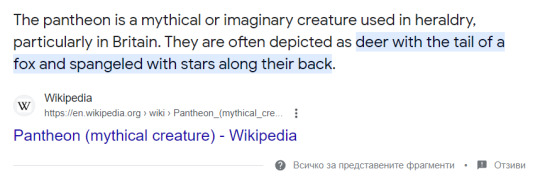
---
I think skill 2 would be healing (if going by Dr. is a 6 star operator theory) and skill 3 is shwinging a couple of waves of petals like waves from a sea. Not to forget Dr. Eve is a Lord and uses a sabre, a weapon picked up before she went into a coma.
Dr. Eve:
Summons originium flower petals, peach in colour and mostly transluscent, which pass through allies and heal them while damaging enemies.
/Her fear was unreasonable because he is too kind and gentle to actually think that her forgetting how to play any instrument would be something unbecoming. She just wants to impress him./
And that she is also a Leithanien, so if she plays any instrument it would be the flute /wood/ or a hurdy-gurdy.
But Czerny doesn't know because she is afraid he might challenge her knowledge and she hasn't touched the instrument for a long while. It was just in her room so she assumed she knew how to play from before.
---
Dr. Lundi's infected eye being flashy and cool and also a little sad to look at.
---
Meanwhile:
XY: Hey Doctor, where is your infection?
Dr. Eve: Pulls a comedically old Xray board over myself showing that everything in a 20cm radius around my heart including is glowing like it's Christmas
She easily gets warm, so temperatures on RI are a maximum of 22C spring/summer and 28C fall/winter.
Dr. Evealia's infection is external, a formation of pure black clusters starting from the back of her neck at the hairline and going around the base of her neck/across her clavicles and upper part of her ribs almost like a necklace. During winter it s easy to cover them and shield them via special wool/cotton scarves, but during the hot seasons Kal'tsit has prescribed her to wear something like a cone if she's not with the Dr.'s coat. It makes it look comically like she's a cat in cone jail, but it's just for her own safety.
The infection thereon becomes internal and has concentrated around her heart.
When her infection begins acting up Dr. Eve begins having heart palpatations and chest pains which leave her winded.
During such a state if she is forced to use arts the scent of the flowers may become simmilar to that of opium, which could lead to addiction. The effect of being exposed for too long to that scent could lead to immune system weakning and inflammation in infected areas.
This is why it's recommended to not leave for a mission with Dr. Eve unless everybody is equipped with masks.
Dr. Evealia also can increase the strenght of her attacks by playing the hurdy gurdy, which is her updated S3 - much like a skalter buff in the sense it last for a set duration and sends waves of petals towards the direction she is facing.
The 'addictive' scent may cause side effects to operators simmilar to an overdose (breathing difficulty and nausea), but the longest that 'overdose' state has ever lasted was during a four hour exposure and it passed only 30 minutes after they were seperated.
Operators overved to become very hungry afterwards.
---
Including music that I stumbled upon accidentally but it feels like something her S3 would be when completely loaded:
youtube
---
Top operators constantly by her side are Czerny, Chongyue and Ebenholz. Around that, Lumen is her designated caretaker around Kal'tsit. Ebenholz, while sworn to stay by her side, also has to wander off often to tend to his headaches. They have a handshake over that because heartache/headache and their brother stomachache are literally the bane of mankind.
As a chimera - fox tail, deer ears and pattern on her back lead to believing that her horns may not be deer horns but something showing sarkaz roots. It's unknown if that's true, just a rumour. They look like completely normal elafia horns though.
---
When the infection acts up Lumen is always around, making sure that the Dr. Has somewhere to sit and something to drink. It's peach juice.
---
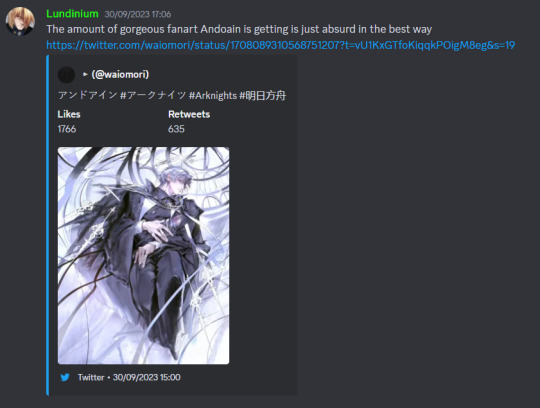
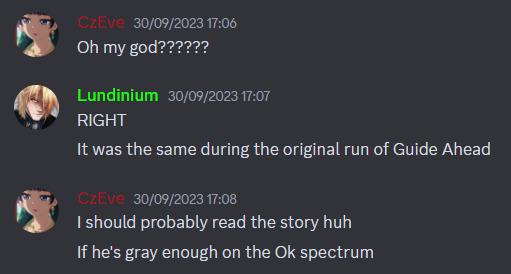

I just thought this is very funny also considering how much I am leaning towards the Sarkaz these days
Also said art in question: Link here
---

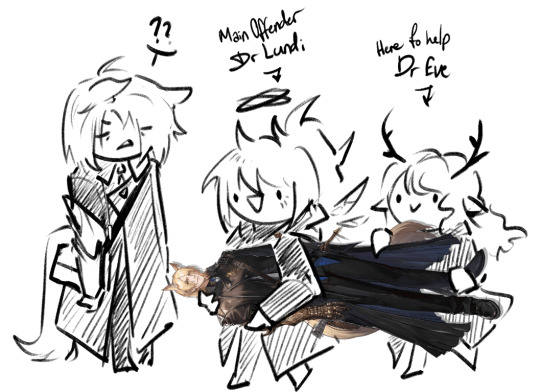
I GOT WHAT I ASKED FOR
---
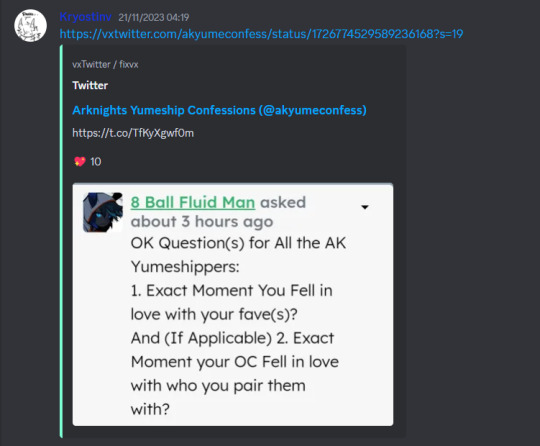

youtube
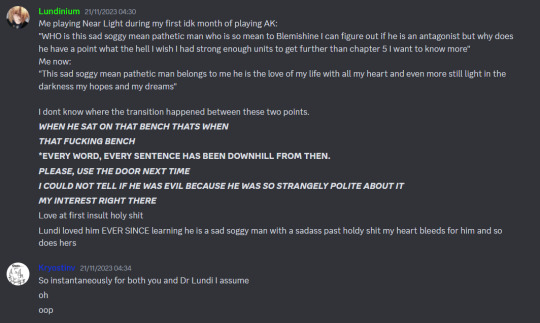


Tweeted question that was aforementioned: Link here
---
Eveader Traditions:
One doesnt eat dinner and one doesnt eat breakfast, but if they are both on Rhodes Island they will eat lunch and dinner together if they can.
Whenever Eve is reading around the fireplace Hoederer sits close and reads with her.
They exchange books often to refresh their mind and broaden their horizons. Hoederer thinks that Eve's books are very imaginative and Eve thinks Hoederer's books are boring but in the end it's more fun when they can pause at any moment to talk about it.
Eve brings Hoederer snacks and Hoederer brings Eve drinks. He's probably the only one who actually bothers her to drink lots of water.
Their walkie talkies are linked so they can talk at any moment
This question is: Linked here
---
So prompted by Dr. Kryo I responded with:
Doc thoughts-
Gifts Dr. Kryo would give to certain folks
Surtr- A Necklace
Dr Lundi- A Signed album of a band she likes
Dr Eve- A rose statue for her desk
Dr Pinkie- A Coupon book with various food places in it
Mostima- A rare snack he saved for her
Pozëmka- An engraved fountain pen
Beehunter- Premium honey with a good amount of strawberries
Nightingale- A post for her bird
Kal'tsit- A mug that says "Ur alright.-kryo"
What Dr. Eve would prepare as presents for her closest ones:
Hoederer - A Diary that consists of all letters/moments we spent together between battles with my thoughts and feelings up to the point I fell in love, after which it begins as something like a love story travel guide I named 'The Story of….' leaving him to continue or not.
Chongyue - A visit to a very spiritually infused with the best of vibes hot springs in the snowy mountains/potentially somewhere to hang out with his sisters later.
Czerny - After long and painstakingly difficult relations with Leithanien, he's allowed to play in the Afterglow again. He freaks out because inside the box Eve gifts him is just a sheet of paper and for a moment he thinks it's an 'Im pregnant' note.
Eve gifts him some of her best alcohol after to mend that awkward but insanely funny situation.
Ebenholz - A gramophone. The sound waves from it are said to lessen headaches. Its a form of therapy.
Lumen - A snow globe of the light tower and a part of the Iberian coast that is a switch-on light.
Dr. Lundi - An entirely decorative gunblade made out of glass with flowers, fields of wheat and house designs already mounted on a black background and framed. The weapon's name is 'Brittle'. Interstingly enough it is in fact not brittle. Due to Lundi's clumsiness it is made out of especially tempered glass that doesnt break when dropped. At least from 1.70 in height.
Dr. Kryo - Brass knuckles in the shape of a dragon head with its fangs being the sharp part of that weapon. They come in pairs red and blue that change to the opposing colour depending on the temeperature.
Dr. Pinkie - A giant tea set with cups, plates, spoons and a tea pot and tea steeper and spoon ring holders and jars for sugar honey and milk that are all in the shape of bizzare sea creatures.
Lee - Her gift for him disappeared, he's taken up the task to find it himself.
Lessig - A new and improved soundproofed room.
SilverAsh - That man has everything and Eve almost cried herself to sleep in Courrier's and Matterhorn's room because their master is such a menace but in the end she gifted him a tail ring with imbedded smoky quartz which shows Tenzin in flight. Tenzin got a leg bracelet with a tiny chubby snow leopard on it that Eve swears is not a caricature of SilverAsh the man.
#arknights#arknights doctor#arknights doctor sona#arknights OCs#Arknights operators mentioned#Dr. Eve has opinions again#OC creation list#Ideas if you will#Christmas and gifts#memes#friendship#banter#delusional doctor#doctor of ri shenanigans#Youtube
6 notes
·
View notes
Text
Step into Style: Visit the Ultimate Tata Harrier EV Showroom at Lakshmi Tata Chennai Today
Discover the All-Electric Tata Harrier at Lakshmi Tata in Chennai
Looking for a bold SUV that matches style with sustainability? The Tata Harrier EV delivers cutting-edge design, premium features, and all-electric performance — all in one stunning package. Whether you're navigating busy city roads or heading out for a long drive, this electric SUV offers zero-emission mobility without sacrificing power or presence.
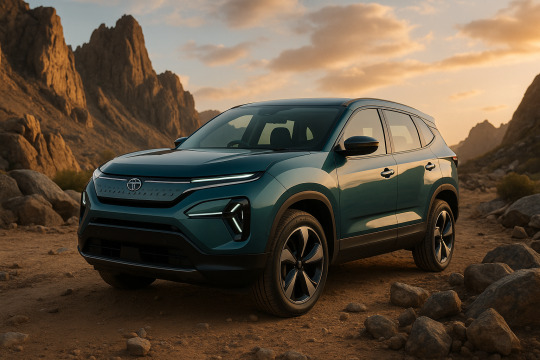
Visit Us!
At Lakshmi Tata in Chennai, we’re proud to bring you the future of Tata’s SUV lineup — offering first access, expert support, and competitive pricing on the all-new Harrier EV.
What Makes the Tata Harrier EV Unique?
All-Electric Performance
Built on Tata’s Gen-2 EV architecture, the Harrier EV offers:
Dual-motor, all-wheel drive capability (available in select variants)
Instant torque for quick, smooth acceleration
Long-range battery for extended travel
Fast-charging options for added convenience
It’s powerful, efficient, and perfect for the roads of Tamil Nadu.
Bold, Modern Design
The Harrier EV retains the commanding presence of its diesel predecessor while introducing:
Distinctive EV badging
Updated front fascia with futuristic styling
Stylish alloy wheels and LED lighting
Aerodynamic enhancements for improved range
A design that reflects innovation — without losing the SUV’s rugged appeal.
Intelligent, Connected Features
Inside the Harrier EV, you’ll find:
Touchscreen infotainment system with connected vehicle technology
Digital instrument cluster
Wireless Android Auto and Apple CarPlay
Multiple drive modes and regenerative braking options
Over-the-air software updates
Enjoy a smarter, more intuitive driving experience with every mile.
Advanced Safety Features
The Tata Harrier EV is engineered for safety, offering:
Multiple airbags
Electronic Stability Program (ESP)
Hill hold and descent control
Rear-view camera with dynamic guidelines
Sturdy body construction for maximum protection
Drive confidently, knowing you and your family are well protected.
Why Choose Lakshmi Tata for the Harrier EV in Chennai?
Exclusive EV Availability
Lakshmi Tata is among the first showrooms in Chennai to offer the Tata Harrier EV. Visit us for:
Priority bookings
Latest availability in all trims and colors
Guided test drives and personalized feature walkthroughs
Be one of the first to own the Harrier EV in your neighborhood.
EV Expertise You Can Trust
Buying an electric vehicle is a big decision. Our EV team supports you through:
Understanding range, charging options, and running costs
EV loan and financing solutions
Details on government incentives and EV subsidies
Home charger installation guidance
Charging network support across Chennai
We’re here to make your transition to electric effortless.
Certified EV Service and Support
Our Tata-authorized service center is fully equipped for EV maintenance. We provide:
Battery health diagnostics
Software upgrades
Trained EV technicians
Genuine Tata parts and support
Service packages and extended warranty options
Enjoy reliable ownership and post-purchase care — every step of the way.
Conveniently Located in Chennai
Lakshmi Tata is easy to reach from all major parts of the city, including:
Anna Nagar
Tambaram
Velachery
OMR and ECR
T. Nagar
Porur and surrounding suburbs
We offer flexible appointments and hassle-free showroom visits, including test drives at your convenience.
Book Your Harrier EV Test Drive Today
Curious about how the Tata Harrier EV performs? Book a test drive at Lakshmi Tata Chennai today and experience the blend of technology, power, and eco-conscious design in person. Our team is here to guide you through everything you need to know.
Step Into the Future with the Tata Harrier EV
If you’re ready to drive a premium SUV that offers both performance and sustainability, the Tata Harrier EV is your next big move. And there’s no better place to explore it than Lakshmi Tata in Chennai — where personalized service, honest pricing, and electric mobility come together.
Visit Lakshmi Tata Chennai today to explore, test, and own the Tata Harrier EV — where innovation meets sophistication.
#tata showroom in chennai#tata dealership in chennai#tata dealers in chennai#tata showroom near me#tata dealership near me#Tata Service centre near me#Tata service in chennai
0 notes
Text

2025 Ford Ranger Review
Get ready for adventure with the 2025 Ford Ranger, redesigned for performance, strength, and smart technology. This midsize pickup is built tough, with added capability and connectivity to handle Canadian roads, trails, and job sites alike.
Walkthrough Review
The cabin of the 2025 Ford Ranger feels more upscale, with a refined layout, soft-touch materials, and clever storage throughout. Available features like leather-trimmed seats and ambient lighting give the interior a modern, premium vibe. The 12-inch centre touchscreen and digital instrument cluster amplify the tech-forward design.
From the bold grille to the muscular wheel arches, the 2025 Ranger brings rugged style. LED headlights are standard, and the Raptor trim boasts off-road-focused bumpers, tow hooks, and exclusive badging. Choose from multiple cab styles and bed lengths to fit your needs.
The new Ranger lineup offers a range of capable engines, including the returning 2.3L EcoBoost and the powerful 2.7L V6. The high-performance Ranger Raptor gets a 3.0L EcoBoost V6 producing 405 horsepower. A 10-speed automatic transmission ensures smooth, responsive driving on and off-road.
Contact Us
Ready to explore the 2025 Ford Ranger? Reach out to a Ford dealership for more details, test drives, and current promotions. Get information related to the Ford Ranger price and the Ford Ranger for sale, and other information. Call or visit the dealership to schedule a test drive with Oakridge Ford.
Frequently Asked Questions
Q: What are the key differences between the 2025 Ford Ranger XL, XLT, Lariat, and Raptor trims?
XL: Entry-level, practical and affordable.
XLT: Adds more features like aluminum wheels and larger displays.
Lariat: Offers premium tech, leather seating, and advanced safety.
Raptor: High-performance off-roader with exclusive suspension and 3.0L V6.
Q: Can you provide an overview of the engine options and their specifications for the 2025 Ford Ranger?
3L EcoBoost I-4: 270 hp / 310 lb-ft torque
7L EcoBoost V6 (available): 315 hp / 400 lb-ft torque
0L EcoBoost V6 (Raptor only): 405 hp / 430 lb-ft torque All paired with a 10-speed automatic.
Q: What are some of the notable new features or changes in the 2025 Ford Ranger compared to previous models?
New design inside and out
Updated tech with SYNC® 4A
Available digital displays and new infotainment features
Introduction of the Ranger Raptor to North America
Q: What are the fuel economy ratings expected for the different engine options in the 2025 Ford Ranger? Official Canadian NRCan ratings are pending, but estimates are:
3L EcoBoost: ~10.6 L/100km combined
7L EcoBoost: ~11.8 L/100km combined
0L EcoBoost (Raptor): ~13.8 L/100km combined
Q: What kind of technology and infotainment features come standard or are available on each trim level of the 2025 Ford Ranger?
XL: 10.1" touchscreen, SYNC® 4
XLT: Upgraded display, power driver’s seat
Lariat: 12" touchscreen, wireless charging, B&O® audio
Raptor: Off-road tech, performance telemetry, surround cameras
Q: What are the towing and payload capacities for the various configurations of the 2025 Ford Ranger?
Max Towing (when properly equipped): Up to 7,500 lbs
Max Payload: 1,711 lbs
Q: Where can I find a Ford dealership near me to inquire about the 2025 Ford Ranger for sale? Visit us- 601 Oxford St W, London, ON N6H 1T8, Canada
1 note
·
View note
Text
APP2 APPRO2 Update: Support BMW G Chassis BDC2 Mileage Repair
APP2 APPRO2 (license FN0050) released a major upgrade on June 7th, 2025. It added mileage repair new function for BMW G chassis BDC2 system.
2025.06.07 Update Info:
✔ BMW G-Series BDC2 Module Enhancement
Now supports mileage repair for BMW BDC2 systems (G-Series)
Free upgrade for all APPRO2 users with authorized functions
Industry-leading capability: While competitors only offer key programming, APPRO2 now delivers full mileage correction

2025.05.27 Update Info:
✔ VW/Audi/Skoda Security Access Upgrade
Added BOOT mode full data reading for NEC+24CXX instrument clusters (2009-2018)
Supports: NEC24C64 / NEC24C32
Requirement: MQB 5A wiring harness


Key Advantages of APPRO2 Now:
All-in-one solution: Key programming + mileage correction for BMW BDC2
Free upgrades: No additional cost for licensed users
0 notes
Text
0 notes
Text
Analog vs. Digital Dash Clusters: Which Is Better for Modern Vehicles?

When you sit inside a car, one of the first things you notice is the dashboard—the cluster of instruments that gives you key information like your speed, fuel level, engine temperature, and more. It’s the central hub that keeps drivers informed and in control while on the road. For decades, these clusters were entirely analog, featuring physical dials and needles that moved mechanically. They were simple, effective, and familiar to most drivers.
But now, with the rise of advanced technology, smarter vehicles, and higher expectations from drivers, digital dash clusters are quickly taking over. These modern systems use high-resolution screens to display the same essential information, but with greater flexibility, customization, and integration with other vehicle systems.
So, which one is better for modern vehicles—analog or digital? In this blog, we’ll explore the differences between analog and digital dash clusters, the pros and cons of each, and how they affect the overall driving experience. Whether you’re buying a new car, upgrading an old one, or just curious about automotive tech trends, this guide will help you understand what’s best for today’s vehicles and why dashboards are evolving fast.
What is a Dash Cluster?
A dash cluster, or instrument cluster, is the panel in front of the driver that displays key vehicle information. This includes:
Speedometer (vehicle speed)
Tachometer (engine RPM)
Fuel gauge
Temperature gauge
Warning lights (e.g., engine, oil, seatbelt)
There are two main types:
Analog Dash Clusters: Use physical dials and needles to show readings.
Digital Dash Clusters: Use electronic displays—like LCD or TFT screens—to show data in a visual, dynamic format.
Understanding Analog Dash Clusters
Analog dashboards have been standard for most of automotive history. These dashboards display readings using mechanical or electromechanical systems. You’ll see spinning needles, rotating dials, and often a simple digital odometer.
Pros of Analog Dash Clusters
Simplicity and Clarity:Analog gauges are easy to understand at a glance. Most drivers are familiar with them and don’t need time to adjust.
Lower Cost:Cars with analog clusters are generally more affordable. There are fewer electronic components to worry about.
Fewer Distractions:Analog displays are static and consistent, helping drivers focus without too many visual elements changing on-screen.
Durability:Mechanical gauges tend to be more resilient over time. They don’t suffer from dead pixels or software glitches.
Cons of Analog Dash Clusters
Limited Information:Analog clusters show only basic data. They can’t display navigation, media info, or custom alerts.
Lack of Customization:You can’t change how your gauges look or rearrange them. What you see is what you get.
No Integration with Advanced Systems:Modern cars come with advanced features like lane assist, real-time maps, and performance metrics, which analog systems can't support.
Understanding Digital Dash Clusters
A digital instrument cluster replaces traditional dials with a screen—often high-resolution and fully customizable. These clusters are becoming standard in luxury cars and are appearing in mid-range models as well.
Pros of Digital Dash Clusters
Customizable Layouts:Drivers can switch between different display modes—performance mode, eco mode, or navigation view. Some even support Custom Digital Dash settings, allowing you to personalize the screen.
More Data at a Glance:Digital clusters can show additional information like turn-by-turn navigation, media playback, weather updates, tire pressure, and more.
Enhanced Visual Appeal:These clusters often look sleek, modern, and futuristic—great for tech-savvy drivers or those who appreciate good design.
Integration with Vehicle Systems:They work seamlessly with infotainment systems, ADAS (Advanced Driver-Assistance Systems), and other smart features in the car.
Improved Night Driving:Brightness and contrast automatically adjust for better visibility without causing eye strain at night.
Cons of Digital Dash Clusters
Higher Cost:Vehicles with digital displays tend to be more expensive due to the advanced hardware and software involved.
Complexity:The abundance of information and custom settings can be overwhelming, especially for older or less tech-friendly drivers.
Potential for Glitches:As with any screen, software bugs or hardware malfunctions can occur. A faulty digital display could leave the driver with no readable info.
Distraction Risk:With animations, alerts, and switching modes, there’s a risk of drivers focusing too much on the screen instead of the road.
Analog vs. Digital: Side-by-Side Comparison

Which One Is Better for Modern Vehicles?
This depends on how you define “better.” For modern vehicles that aim to provide an advanced driving experience, digital instrument clusters offer greater flexibility, interactivity, and data. They are perfect for tech-driven cars with connected features and intelligent systems.
However, analog clusters still have a place in the market. They are easier to maintain, less prone to tech issues, and provide a nostalgic or minimalist driving feel. Budget vehicles and some classic-style models still favor analog clusters for their simplicity and reliability.
Ultimately, the “better” option depends on your preferences and driving needs:
Daily commuter? Analog might suit you just fine.
Tech lover or long-distance driver? You’ll likely benefit from a digital system.
Car enthusiast? You might prefer a custom digital dash for performance stats, track data, and visual flair.
The Rise of Hybrid Clusters
To bridge the gap, many manufacturers now offer hybrid instrument clusters, combining analog-style dials with a small digital screen in the center. This gives drivers the best of both worlds:
Familiar dials for basic info
A digital section for navigation, calls, or system alerts
Examples include models from Toyota, Hyundai, and Ford, which give buyers flexibility without fully committing to digital.
Use Cases: When Digital Really Shines
1. Navigation Support
Digital clusters often sync with GPS and show maps directly behind the steering wheel, reducing the need to look sideways at the infotainment screen.
2. Electric Vehicles (EVs)
EVs often need to display new types of information—like battery range, charging status, and energy usage. A digital display makes this easier to interpret.
3. Performance Driving
For sports cars or track use, drivers benefit from a custom digital dash that shows lap times, G-forces, and engine performance metrics.
4. Luxury Cars
Premium brands like Mercedes-Benz, BMW, and Audi are making fully digital clusters standard across their lineup to reflect modernity and status.
Future Trends in Dash Clusters
Augmented Reality (AR):Some vehicles now project data onto the windshield using AR, showing speed, navigation, and warnings in the driver’s line of sight.
Voice Integration:Dash clusters will soon be fully voice-enabled, letting you switch views or get information hands-free.
Cloud-Connected Dashboards:Expect real-time traffic, weather, and system diagnostics streamed directly to your display.
Full Personalization Profiles:Your driving profile might auto-load your preferred layout, lighting, and theme the moment you start the car.
Making the Right Choice
If you’re shopping for a car or upgrading your dash, ask yourself:
Do I want modern features or classic simplicity?
Am I comfortable with tech-heavy systems?
Do I need real-time maps, media info, or system alerts?
What’s my budget?
If customization, connectivity, and visual appeal matter most, a digital instrument cluster is the way to go. If simplicity and durability are your top priorities, analog still has its place.
Final Thoughts
The dashboard has come a long way—from a basic panel of gauges to a sophisticated, interactive display that plays a vital role in how we drive. It’s no longer just about speed and fuel—it’s about real-time data, seamless connectivity, and personalized driving experiences. Whether you’re drawn to the classic charm and simplicity of analog dials or excited by the sleek design and functionality of a digital display, there’s an option to suit every driver.
As the automotive industry continues to innovate, digital dash clusters—especially those offering custom digital dash features—are quickly becoming the new norm. With the ability to display a wide range of vehicle data, adapt to driving modes, and even integrate with smartphones and navigation, digital systems offer unmatched flexibility and convenience. However, analog dashboards still appeal to many drivers who appreciate their straightforward layout and traditional feel.
Ultimately, the right dashboard for you depends on your personal preferences, the type of vehicle you drive, and how comfortable you are with modern technology. Whether you're upgrading your current car or purchasing a new one, understanding your dashboard options can help you make a better, more informed choice.
In the end, the best dashboard is the one that enhances your driving experience—offering you confidence, clarity, and control every time you get behind the wheel.
0 notes
Text
Automotive Smart Display Market Drivers Include Connectivity, Safety, and Advanced Display Integration
One of the main drivers influencing the automotive smart display market is the surging demand for vehicle connectivity. Modern consumers expect cars to be extensions of their digital lifestyles, leading manufacturers to integrate smart displays capable of handling navigation, music, calls, messaging, and real-time vehicle diagnostics. These connected systems provide drivers with seamless access to smartphone features through interfaces such as Apple CarPlay, Android Auto, and proprietary OEM infotainment platforms. The integration of IoT and cloud-based services within smart displays further enhances user experience and offers new functionalities like predictive maintenance alerts and real-time traffic updates.

Increasing Emphasis on Safety and ADAS Safety is another strong driver propelling the adoption of automotive smart displays. As advanced driver assistance systems (ADAS) become standard in new vehicles, the need for clear, integrated display units has grown significantly. Smart displays offer a centralized view of data from lane departure warning, blind-spot detection, adaptive cruise control, and parking assist systems. Head-up displays (HUDs), which project vital driving information onto the windshield, are increasingly preferred for minimizing driver distraction. The ability to combine critical safety alerts and real-time data within the driver’s line of sight has become a key selling point for OEMs and a major growth driver for the market.
Shift Toward Digital Instrument Clusters Another crucial driver is the transition from analog to digital instrument clusters. Automakers are replacing traditional gauges with customizable digital displays that enhance vehicle aesthetics while offering versatility. Digital clusters allow dynamic information presentation, including speed, navigation, fuel status, and ADAS alerts, all tailored based on driving conditions and user preferences. This evolution not only improves user experience but also contributes to vehicle brand differentiation in a competitive market.
Rise of Electric and Autonomous Vehicles The growth of electric vehicles (EVs) and autonomous driving technologies is accelerating the demand for smart displays. EVs require advanced display solutions to present information on battery status, range, energy consumption, and regenerative braking. In autonomous vehicles, passengers are more likely to engage with infotainment and comfort controls, increasing the importance of interactive and visually appealing display systems. Automotive smart displays serve as the central hub for managing vehicle functions, making them indispensable in the next-generation mobility ecosystem.
Consumer Demand for In-Vehicle Infotainment Today’s consumers are increasingly valuing in-vehicle infotainment experiences. Smart displays serve as the interface for a wide array of entertainment features, such as video streaming, music applications, games, and internet browsing. Rear-seat entertainment systems with smart touch displays are also gaining popularity in high-end and mid-range vehicles. Automakers are capitalizing on this trend by offering larger and more responsive screens, which is further driving the market forward.
Technological Advancements in Display Panels Another important driver is the ongoing innovation in display technologies, including OLED, QLED, AMOLED, and micro-LED. These technologies enable slimmer, brighter, and more energy-efficient displays with improved contrast and touch sensitivity. Curved and flexible display panels are also being explored to enhance cabin ergonomics and design. These technological upgrades not only meet aesthetic demands but also help reduce power consumption—an essential factor in EVs—making them increasingly attractive to manufacturers.
Regulatory Push for Vehicle Safety Standards Governments around the world are introducing stringent vehicle safety regulations, mandating features like rear-view camera displays, driver monitoring systems, and eCall emergency response, all of which depend on integrated smart displays. This regulatory push is particularly prominent in Europe and North America, where compliance with these norms requires upgraded vehicle interfaces. The regulatory framework acts as a direct market catalyst, compelling OEMs to adopt smart display solutions.
OEM and Tier 1 Supplier Collaborations Collaborations between original equipment manufacturers (OEMs) and Tier 1 suppliers have intensified to bring more intelligent, feature-rich display units to market. Major automotive brands are working closely with display technology leaders to develop customized solutions tailored to specific models and segments. These collaborations are fostering innovation, accelerating time-to-market, and ensuring scalability across different vehicle platforms, ultimately driving market expansion.
Cost Reductions Through Mass Production As production volumes rise and technology matures, the cost of automotive smart displays is gradually decreasing. Economies of scale are making advanced displays more affordable, enabling their inclusion even in entry-level and compact cars. This democratization of technology is helping drive broader market penetration and expanding the consumer base.
Conclusion The automotive smart display market is being actively driven by a combination of consumer preferences, regulatory mandates, and rapid technological innovations. With increased emphasis on safety, connectivity, electric mobility, and infotainment, the demand for smart display units is expected to grow across all vehicle categories. As more OEMs invest in digital cockpit solutions and autonomous driving capabilities, smart displays will remain at the center of this transformation, reinforcing their importance in the future of automotive technology.
0 notes